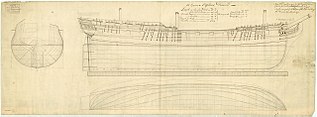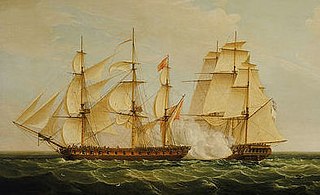
The first USS Randolph was a 32-gun frigate in the Continental Navy named for Founding Father Peyton Randolph, the president of the First Continental Congress.

HMS Bristol was a 50-gun Portland-class fourth-rate ship of the line, built for the Royal Navy in the 1770s. She served as a flagship during the Battle of Sullivan's Island, Charleston, South Carolina in 1776 during the American Revolutionary War and later participated in the 1783 Battle of Cuddalore during the Anglo-French War of 1778–83. By 1787 the ship had been converted into a church ship. Converted into a prison ship in 1794, Bristol instead served as a hospital ship until she was broken up in 1810.

The fourth HMS Diamond was a modified Lowestoffe-class fifth-rate frigate ordered in 1770, launched in 1774, but did not begin service until 1776. Diamond served off the eastern North American coast and shared in the capture at least one brig during the American Revolutionary War. The frigate was paid off in 1779, but returned to service the same year after being coppered. Diamond sailed to the West Indies in 1780, was paid off a final time in 1783 and sold in 1784.
HMS Terrible was a 74-gun third rate ship of the line of the Royal Navy, built by John Barnard and launched on 4 September 1762 at King's Yard in Harwich, as a sister ship to HMS Arrogant.

HMS Lowestoffe was a 32-gun fifth-rate frigate of the Royal Navy. Built during the latter part of the Seven Years' War, she went on to see action in the American War of Independence and the French Revolutionary War, and served often in the Caribbean. A young Horatio Nelson served aboard her shortly after passing his lieutenant's examination.

HMS Surprise was a 28-gun Enterprise-class sixth-rate frigate of the Royal Navy, which served throughout the American Revolutionary War and was broken up in 1783.

HMS Juno was a 32-gun Richmond-class fifth-rate frigate of the Royal Navy. She was launched in 1757 and served throughout the American Revolutionary War until scuttled in 1778 to avoid capture. On 5 June, 1777 she, HMS Juno, and HMS Orpheus recaptured privateer brig "Lucy" 15 Leagues off Nantucket. On 9 July, 1777 she captured Betsy in Boston Bay. On 9 January, 1778 she captured French snow David 3-4 miles off the north east tip of Block Island. She engaged USS Providence during Providence's escape from Providence, Rhode Island 30 April 1778.

HMS Pallas was one of the three 36-gun Venus-class fifth-rate frigates of the Royal Navy. She was launched in 1757 and initially served in Sir Edward Hawke's fleet blockading the coast of France where she fought at the Raid on Cherbourg and in the Battle of Bishops Court. She later served for a number of years in the Mediterranean Sea before moving to serve off the coast of Africa between 1774 and 1776 where she protected the isolated British colonies. In 1778 she joined the Newfoundland Station and participated in the attack on Saint Pierre and Miquelon. Pallas returned to the English Channel after this and assisted in destroying a French invasion force intended for the Channel Islands in 1779 before briefly serving on the Jamaica Station. In 1783 she was beached on São Jorge Island after she was found to be heavily leaking; she was burned there on 24 February.

HMS Levant was a 28-gun sixth-rate frigate of the Coventry class, which saw Royal Navy service against France in the Seven Years' War, and against France, Spain and the American colonies during the American Revolutionary War. Principally a hunter of privateers, she was also designed to be a match for small French frigates, but with a broader hull and sturdier build at the expense of some speed and manoeuvrability. Launched in 1758, Levant was assigned to the Royal Navy's Jamaica station from 1759 and proved her worth by defeating nine French vessels during her first three years at sea. She was also part of the British expedition against Martinique in 1762 but played no role in the landings or subsequent defeat of French forces at Fort Royal.

HMS Racehorse was an 18-gun ship-rigged sloop of the Royal Navy. Originally the French ship Marquis de Vaudreuil, she was captured by the Royal Navy in 1757 and refitted as a survey vessel for the 1773 Phipps expedition towards the North Pole. Renamed HMS Thunder in 1775, she was captured back by the French in 1778.

The Battle of Turtle Gut Inlet was an important, early naval victory for the Continental Navy and the future "Father of the American Navy", Captain John Barry. It was the first privateer battle of the American Revolutionary War. The battle resulted in the first American casualty of the war in New Jersey, Lieutenant Richard Wickes, brother of Captain Lambert Wickes. It was the only Revolutionary War battle fought in Cape May County.

Richard Wickes was an officer in the Continental Navy during the American Revolutionary War. He served as the third lieutenant on the Reprisal, captained by his brother Lambert Wickes. During the Battle of Turtle Gut Inlet, he was the first American casualty of the war in New Jersey.

Nancy was an American sailing vessel, noted in sources as either a brig or a brigantine, that was chartered to transport war supplies during the American Revolutionary War. After learning that independence had been declared, her captain, according to his daughter, raised the first American flag in a foreign port. Evading British capture, she was later intentionally destroyed with a huge blast on June 29, 1776, during the Battle of Turtle Gut Inlet near Cape May, New Jersey.

HMS Kingfisher was the second ship in the 14-gun Swan class of ship sloops, to which design 25 vessels were built in the 1760s and 1770s. She was launched on 13 July 1770 at Chatham Dockyard, and completed there on 21 November 1770. She took part in the American Revolutionary War, enforcing the blockade of the Delaware Bay, and served in the Battle of Turtle Gut Inlet, near Cape May, New Jersey. While under the temporary command of Lieutenant Hugh Christian, she was burnt by her own crew to avoid capture on 7 August 1778 in Narragansett Bay during the Battle of Rhode Island.

HMS Pearl was a fifth-rate, 32-gun British Royal Navy frigate of the Niger-class. Launched at Chatham Dockyard in 1762, she served in British North America until January 1773, when she sailed to England for repairs. Returning to North America in March 1776, to fight in the American Revolutionary War, Pearl escorted the transports which landed troops in Kip's Bay that September. Much of the following year was spent on the Delaware River where she took part in the Battle of Red Bank in October. Towards the end of 1777, Pearl joined Vice-Admiral Richard Howe's fleet in Narragansett Bay and was still there when the French fleet arrived and began an attack on British positions. Both fleets were forced to retire due to bad weather and the action was inconclusive. Pearl was then despatched to keep an eye on the French fleet, which had been driven into Boston.

HMS Amazon was a 32-gun fifth-rate frigate of the Royal Navy, armed with a main battery of twenty-six 12 pounders and launched at Rotherhithe shipyard in 1773. She was first commissioned in February 1776 for war in America where she took part in operations against New York. Returning to England in February 1779, Amazon underwent a refit before serving in the English Channel and North Sea. In April 1780, she sailed to the Leeward Islands where, in October, she was almost wrecked in a hurricane.
HMS Glory was a 32-gun fifth-rate Niger-class frigate of the Royal Navy, and was the second Royal Navy ship to bear this name.
John Barnard (1705–1784) was an 18th century English shipbuilder serving the Royal Navy.
Sir John Williams (1700–c.1784) was a British shipbuilder and designer who rose to be Surveyor of the Navy, the highest position in British naval architecture.















